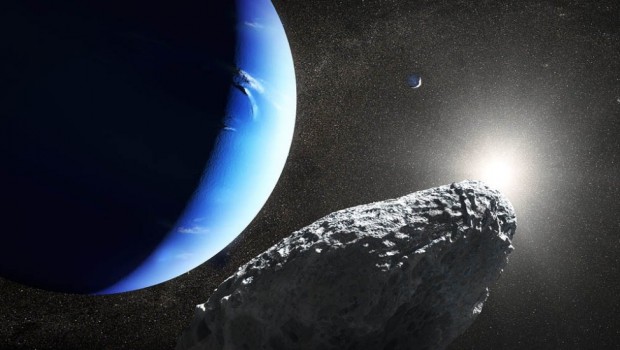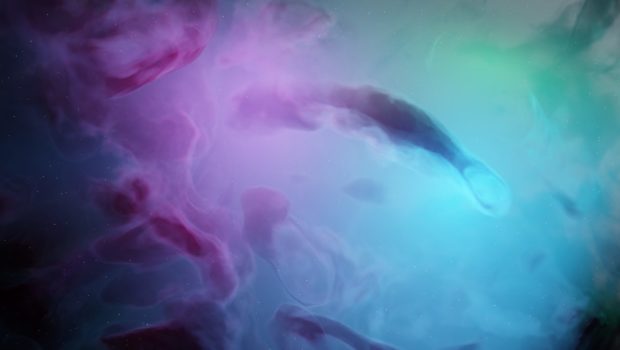
State-of-the-art research station launched in orbit of Neptune
SOL SECTOR — Starfleet Command proudly announced today the formal dedication of Trident Science Station in geosynchronous orbit of the planet Neptune.
The brand new, state-of-the-art outpost will have dedicated facilities for numerous scientific disciplines and will serve as a hub of investigative efforts for the planet itself and the adjacent Kuiper belt of asteroids and moonlets. Neptune, the outermost planet of the Sol system, is still largely a mystery to Starfleet Science, something Trident Station hopes to change.
Among the station’s advanced facilities are an elaborate astrometrics center, multiple geo-scientific laboratories, and a full suite of chemical analysis resources. The facilities aboard Trident Station will be shared by Starfleet Science and a variety of independent contractors. Starfleet Science has inaugurated the launch of a three-year mission into comprehensive mapping of Neptune in multiple ranges of the electromagnetic spectrum. Renowned astrophysicist Dr. John Till is scheduled to lead this mission.
“Neptune has a special place in the Sol system,” said Dr. Till to reporters at the announcement. “Apart from it being the farthest planet from the sun, research projects conducted over the last century have indicated that it has somehow shifted positions with Uranus in the distant past.”
Dr. Till went on to say investigating whether this was an intentional event orchestrated by some unknown force or a natural process will be a core mystery that the station’s mission seeks to unravel.
“The results of our efforts will provide insight in multiple fields of study, including cosmology and cosmogony,” he added.
Starfleet Science has indicated that there are numerous future projects in line for Trident station. Among these is a possible investigation of the galactic core itself. Dr. Till indicated he is actively seeking collaboration with noted Vulcan astrophysicist Dr. Astin, a leading expert on gravitational singularities, to lead this investigation. Dr. Astin is currently aboard the station for a part-time mission, investigating gravitational waves using the new high sensitivity astrometrics array available at Trident.
“The study of giga-energy systems, such as black holes and gravity wells, is important for both the safety of astrometrics and as a means of achieving insights into galactic formation,” said Dr. Astin.
Trident Station’s astral position was modeled on V’Kali Station, which orbits the outer planet of the 40 Eridani A system, also known as the home system of the Vulcans. V’Kali Station will be partnering with the efforts aboard Trident, using their existing array of deep space telescopes to provide an additional layer of observational data of Neptune itself. The purpose of this two-fold approach is to investigate the historical planetary formation process by observing light which is only now arriving in the Vulcan system after its sixteen light-year journey.
Beyond the purely scientific facilities, several groups have already expressed an interest in providing goods and services aboard Trident. Members of the Ferengi Trade Alliance have eagerly set up shop to act as one of the station’s suppliers.
“Trident station is close to Earth, which allows for much profit to be gained for the Alliance,” said Daemon Wart, leader of the FTAs delegation.
In addition, Tellarite political science professor Dr. Ellaris of the Tellarite Educational Outreach Embassy will be using space aboard the station to open a School of Debate.
“[My aim is to] educate the humans of the Sol system in the art of Tellarite political debate,” said Dr. Ellaris. “This will bring future members of the Federation Council much-needed expertise.”
Dr. Ellaris also indicated that Trident station will allow Tellarite scientists to investigate gas giants, a type of stellar body their own star system is lacking. The Tellarite government will also be cooperating with noted anthropologist Dr. Emily Paskin in a small project investigating the possibilities of founding a colony on Neptune’s largest moon, Triton. Trident Station’s proximity to the moon will make it a natural jumping off point for any such future efforts.
- Starfleet Cargo Fleet celebrates 50th Anniversary with Warp 9 upgrade announcement - 240107.01
- Federation and Klingon officials meet to discuss joint science mission in the Azure Nebula - 240002.08
- USS Kuipers begins mission in Illyr System - 239807.09
- Fire on Haldon IV Engulfs Forest - 239802.12
- USS Moniy Finds Ancient Alien Runes On Mars - 239712.25
- Starfleet Science Opens New Academy Near Cardassian DMZ - 239712.11
- Surprise Avalanche Buries Geological Surveying Team - 239710.02
- Orion Syndicate Attacks Increase Alarmingly As USS Zeeman Raided - 239709.25
- State-of-the-art research station launched in orbit of Neptune - 239605.29
- Faculty choice for new Klingon history courses at University of Alpha Centauri brings controversy - 239604.10


 Previous Article
Previous Article Next Article
Next Article Discovered remnants of a possible pre-warp culture on Eta Corvi V
Discovered remnants of a possible pre-warp culture on Eta Corvi V  The Shoals 3GN – everything we know so far
The Shoals 3GN – everything we know so far  Ripples in the Pond – The Consequences of Time Travel
Ripples in the Pond – The Consequences of Time Travel  Levodian Flu outbreak spreads across Earth
Levodian Flu outbreak spreads across Earth  Fire on Haldon IV Engulfs Forest
Fire on Haldon IV Engulfs Forest  Crew of Earth Starfleet vessel rescued from P-409 Sigma after missing for two centuries
Crew of Earth Starfleet vessel rescued from P-409 Sigma after missing for two centuries  Federation and Klingon officials meet to discuss joint science mission in the Azure Nebula
Federation and Klingon officials meet to discuss joint science mission in the Azure Nebula